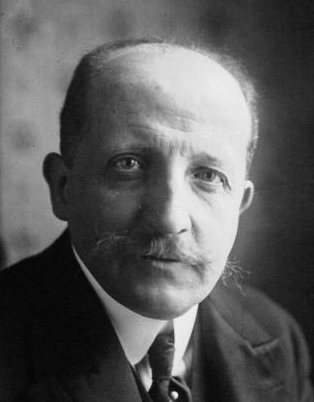
Leopold III was King of the Belgians from 23 February 1934 until his abdication on 16 July 1951. At the outbreak of World War II, Leopold tried to maintain Belgian neutrality, but after the German invasion in May 1940, he surrendered his country, earning him much hostility, both at home and abroad.

The National Bank of Belgium has been the central bank of Belgium since 1850. The National Bank of Belgium was established with 100% private capital by a law of 5 May 1850 as a naamloze vennootschap (NV). It is a member of the European System of Central Banks and the Eurosystem. Until January 1999 when Belgium adopted the euro, the bank was responsible for the former national currency, the Belgian franc.

Hubert Marie Eugène Pierlot was a Belgian politician and Prime Minister of Belgium, serving between 1939 and 1945. Pierlot, a lawyer and jurist, served in World War I before entering politics in the 1920s. A member of the Catholic Party, Pierlot became Prime Minister in 1939, shortly before Belgium entered World War II. In this capacity, he headed the Belgian government in exile, first from France and later Britain, while Belgium was under German occupation. During the German invasion of Belgium in May 1940, a violent disagreement broke out between Pierlot and King Leopold III over whether the King should follow the orders of his ministers and go into exile or surrender to the German Army. Pierlot considered Leopold's subsequent surrender a breach of the Constitution and encouraged the parliament to declare Leopold unfit to reign. The confrontation provoked a lasting animosity between Pierlot and other conservatives, who supported the King's position and considered the government's exile to be cowardly.

Alexandre Galopin was a Belgian businessman notable for his role in German-occupied Belgium during World War II. Galopin was director of the Société Générale de Belgique, a major Belgian company, and chairman of the board of the motor and armaments company Fabrique Nationale d'Armes de Guerre (FN). At the head of a group of Belgian industrialists and financiers, he gave his name to the "Galopin Doctrine" which prescribed how Belgian industry should deal with the moral and economic choices imposed by the occupation. In February 1944, he was assassinated by Flemish collaborators from the DeVlag group.

Charles-Mathias Simons was a Luxembourg politician and jurist. He was the third Prime Minister of Luxembourg, serving for seven years, from 1853 until 1860.

Georges (George) Emile Léonard Theunis was the prime minister of Belgium from 16 December 1921 to 13 May 1925 and again from 20 November 1934 to 25 March 1935. He was governor of the National Bank of Belgium (NBB) from 1941 until 1944. He was the minister of Finance from 1920 to 1925.

Alfons "Fons" Remi Emiel, Viscount Verplaetse was a Belgian economist who served as Governor of the National Bank of Belgium (NBB) from 1989 until 1999. He was one of the architects of the devaluation of the Belgian Frank in 1982 when he worked at the cabinet of Wilfried Martens in the government Martens V. As governor of the NBB, he prepared the entry of Belgium to the euro in 1999.
Hubert Ansiaux was a governor of the National Bank of Belgium (NBB) from 1957 until 1971.
Baron Jean Godeaux was a Belgian economist, civil servant and former governor of the National Bank of Belgium (NBB) from 1982 until 1989.
Maurice Frère was a Belgian civil servant and governor of the National Bank of Belgium (NBB) from 1944 until 1957. He lectured at the Free University of Brussels.

André-Eugène Pirson was a Belgian liberal politician, civil servant, and former governor of the National Bank of Belgium (NBB) from 1877 until 1881. From 1857 to 1861, he was a member of the Belgian Chamber of Representatives.

Alexandre Marie Auguste Jamar was a Belgian businessman, liberal politician, and former governor of the National Bank of Belgium (NBB) from 1882 until 1888. From 1868 to 1870, he was the minister of public works in the government of Walthère Frère-Orban.

Léon Van der Rest (1846–1932) was a Belgian lawyer, businessman and governor of the National Bank of Belgium (NBB) from 1918 until 1923.
Fernand Hautain (1858–1942) was a Belgian businessman and governor of the National Bank of Belgium (NBB) from 1923 until 1926.
Georges Janssen was a Belgian lawyer, civil servant and governor of the National Bank of Belgium (NBB) from 1938 until 1941. During his time as governor he had to defend the Belgium currency from speculative attack during 1938 and he came into conflict during the Nazi occupation during World War II that led to his death.
Luc Coene was a Belgian economist. He was Governor of the National Bank of Belgium (NBB) from April 2011 until March 2015.

The Belgian Government in London, also known as the Pierlot IV Government, was the government in exile of Belgium between October 1940 and September 1944 during World War II. The government was tripartite, involving ministers from the Catholic, Liberal and Labour Parties. After the invasion of Belgium by Nazi Germany in May 1940, the Belgian government, under Prime Minister Hubert Pierlot, fled first to Bordeaux in France and then to London, where it established itself as the only legitimate representation of Belgium to the Allies.

Marcel-Henri Jaspar, was a Belgian lawyer, politician, and later diplomat. He is best known for his unsuccessful attempt with Camille Huysmans and others to establish an unrecognised Belgian government in London in 1940 during World War II.

Albert De Vleeschauwer, later Baron Albert De Vleeschauwer van Braekel, was a Belgian politician of the Catholic Party.
Count Albert-Émile de Beauffort was a Belgian colonial administrator.











